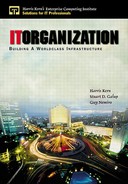Start Simple
The preceding list of characteristics depicts the ultimate computing environment for IT and the corporation. To get there is a long and tedious ordeal. It's an evolutionary process that could take up to two years. But you need to start somewhere. If you take it all on you will surely fail. We list the steps in prioritized order, and you should not deviate from this sequence.
After the second step we recommend that you take on step three as soon as possible. We ask that you start by implementing or fixing the three most critical processes only to get some successes under your belt before taking on the entire scope outlined in Table 4-1—please, no more or less to start than with the three most critical processes in IT:
Change control
Problem management
Client/Server production acceptance
All are critical. There really is no way to prioritize them. Depending on the size of your shop, it could take six months to a year to complete this step. But these are the minimum requirements to building that elusive worldclass infrastructure. You cannot wait any longer.
The fourth step is the whole enchilada. It's documenting your services, implementing metrics, and benchmarking your services.
The fifth step is the icing on the cake. Chances are that very few will ever take on this step, but if you have plenty of time and resources, then go for it!
The Simple Five-Step Program
We in IT have been trying to take on too much at one time. As we said earlier, the infrastructure is so far behind that it would be futile and a sure formula for failure to take on everything at one time. Start simple! Follow the five-step process that follows and you will succeed.
Building a worldclass infrastructure is a five-step process. Table 7-1 highlights the process:
| Step | Process |
|---|---|
| One | One-to-two day infrastructure assessment |
| Two | Organizational analysis and restructuring |
| Three |
Establish processes:
|
| Four |
|
| Five | Implementing remaining processes in Table 5-1 |
Step 1
The first step is information gathering that is our one- to two-day assessment process. An outside consultant (see Appendix A for the program) should perform the appraisal.
Step 2
The second step will always be a detailed organizational analysis and restructure. Notice that we said "always." Remember 40 of 40—that's 100 percent—companies had organizational issues with which to contend. The interviewee doesn't say that, but many of the issues he or she brings up always point back to the organization.
The process is quite simple (see Table 7-2). Our role is that of the facilitator. We guide and mentor the team.
| Process | Duration |
|---|---|
| Management meetings to understand the current organization, business issues, political atmosphere and some of the key players. We also discuss the process of this organization assessment and restructure. | 4 hours |
Management gathers at an offsite location to share IT goals, initiatives, and functional responsibilities. Then the group holds discussions on restructuring the organization to resolve top issues from the 1 to 2 day high-level infrastructure assessment. The offsite agenda will be to:
| 2 days |
| Technical staff gathers at an offsite meeting to understand functional responsibilities. The purpose is to discuss key issues and map out a new organization structure that tackles the issues and prepares for future initiatives. The offsite agenda will be the same as above. | 1 to 2 days |
| Meet with management to compare notes from technical session. | 2 hours |
| Interview key personnel to acquire additional data if required. | 1 to 2 days |
| Assemble report. | 5 to 8 days |
| Present findings to senior executive. | 2 to 4 hours |
Step 3
Step 3 is the very important process design and implementation. But before you can implement processes you need to define your scope of production (see our book titled Building the New Enterprise for a detailed explanation of how to define the scope of production). Once identified, design and implement no more than three of the processes outlined in Step 3 that are missing. We say only three because you need to get these right. The infrastructure review highlights the most critical processes to implement and usually the most comprehensive. Get these right first.
Step 4
Step 4 is designing and implementing metrics, documenting services, costing services and benchmarking the services with external sources (i.e., vendors, competitors, etc.). See Chapters 8 and 9 of Building the New Enterprise.
Step 5
The fifth step is to implement the rest of the processes in Table 5-1. As of August 1999, the 40 companies we studied did not have the first four steps implemented. Step 5 is what we refer to as icing on the cake. If you get this far, please e-mail us.
